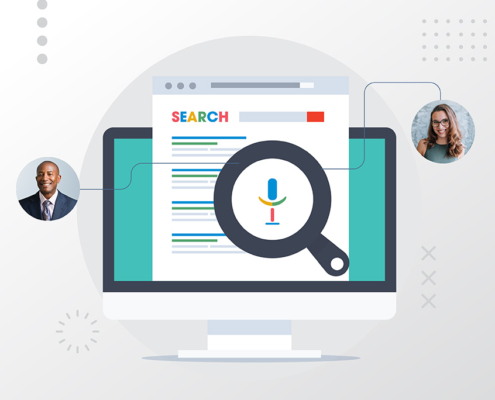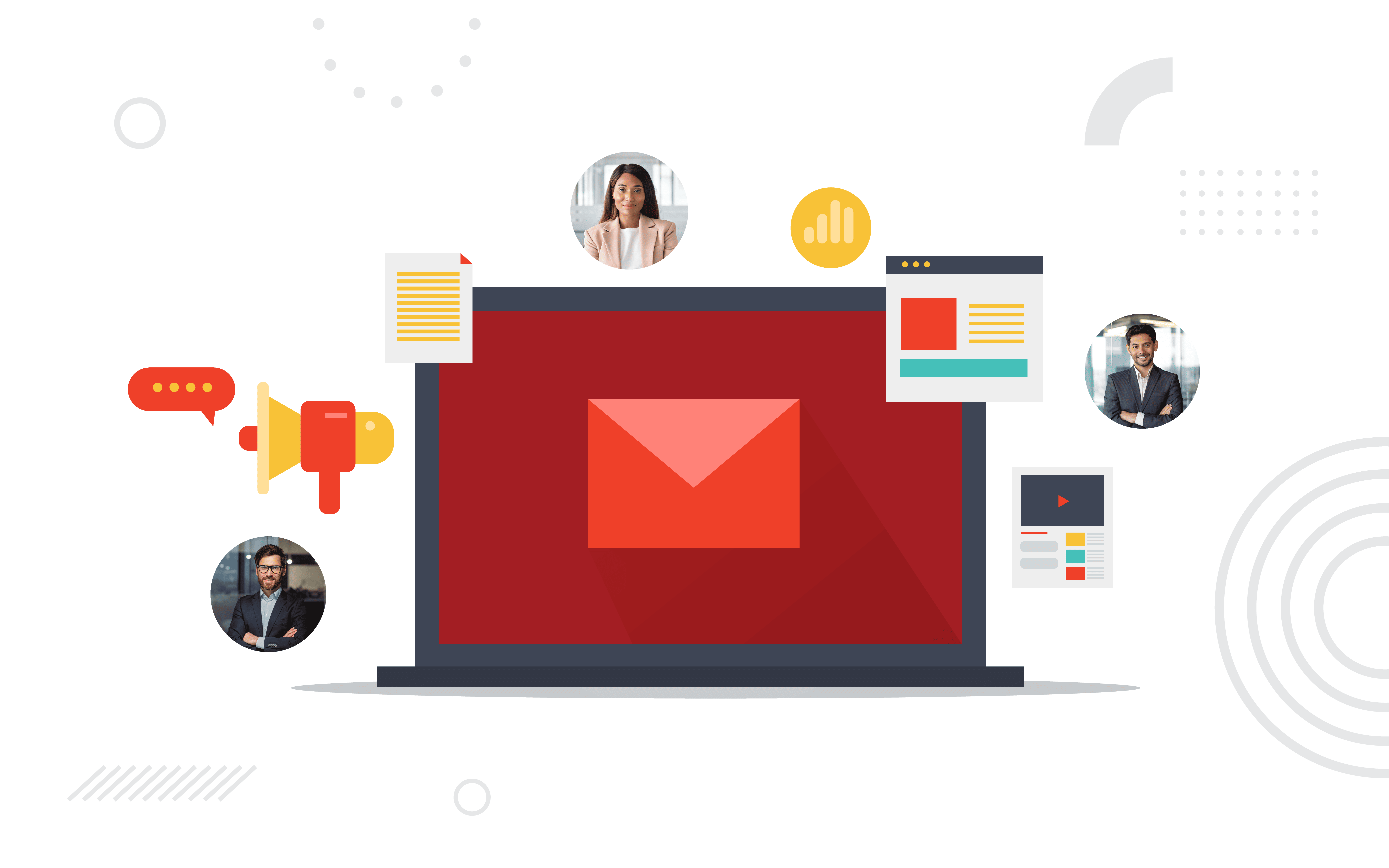

Writing an email is easy—you just type a few words to get your point across and press send, right?

Writing a sales email is a whole other ball game that comes with a lot of challenges. Email is a great way to generate leads, but it’s important to remember that there are right and wrong ways to do it.
B2B email marketing is a skill that very few small businesses know how to use to their advantage, and that’s because people are hard to please. If they’re not engaged in 0.2 seconds, they’ll immediately look for the next thing that gives them a little dopamine boost.
We get it—it sounds intimidating. But it doesn’t have to be as long as you have the proper guidance on B2B email marketing best practices. Here are some ways your sales teams can attract potential buyers in your target market and retain their interest:
- Write compelling subject lines
- Create email lists around your buyer personas
- Take advantage of personalization (but not too much)
- Avoid spamming—make content relevant
- Don’t forget a call to action (CTA)
- Design email templates to fit any device
- Automate your email marketing campaigns
- Use data to measure the effectiveness of your campaign
- Distribute the right sales emails at the right time
Write Compelling Subject Lines
A subject line is the first interaction a prospect has with your business. While the email contents themselves are important, a compelling subject line is typically the deciding factor for whether or not they want to open the email.
As you write subject lines, they must be compelling, clear, and concise, so the potential buyer knows what the email contains. Here are a few subject line best practices to consider implementing into your B2B email marketing campaign:
- Personalize verbiage to the recipient
- Keep it short yet descriptive
- Limit your use of punctuation
- Create a sense of urgency
Here are some example subject lines we use in our email marketing campaigns:
New B2B Opportunities are Heading Your Way!
Sales Pipeline Looking Slim?
Non-Tailored Lead Gen Efforts are Stunting Your Growth
High-Converting B2B Leads are Waiting for You
Looking to Ramp Up Your Growth Efforts in 2024?
Create Email Lists Around Your Buyer Personas
Every prospect in your sales pipeline has different wants, needs, and interests, which is why your sales reps and marketing experts must create email lists that segment each of their needs. While segmenting potential buyers based on their interests is crucial, it’s definitely not the only factor to consider:
- The industry they serve
- The size of their company
- Their job title
- Their stage in the buyer’s journey
- And more
Creating email lists around buyer personas ensures that each email sent to potential customers is relevant and aligns with what they may be looking for. This further guides them to the end of the sales funnel.
Take Advantage of Personalization (But Not Too Much)
Sending personalized emails is a great way to engage potential buyers because it shows that your company genuinely cares about the success of their business. However, it’s important to remember that while personalization is a great B2B email marketing best practice, sales emails can be too personalized and potentially turn off high-quality leads.
If sales emails are too personalized, you risk representing your company in a negative light. Additionally, it could potentially cause legal trouble due to an invasion of privacy. To effectively personalize your sales emails, it’s vital that your B2B marketers:
- Market to buyer personas, not individuals
- Create multiple buyer personas, so each email is unique
- Keep personas timely and relevant to your company
Avoid Spamming—Make Content Relevant
Contrary to popular belief, cold emailing is not spam emailing; many people tend to get those two confused. While a cold email can become spam if it’s not done correctly, this isn’t always the case. And ideally, it shouldn’t be.
To avoid your cold emails turning into spam, it’s essential that you keep content relevant to the sender. If the content is irrelevant for too many people on your email list and they all unsubscribe, you increase the risk of having a poor sender reputation.
Here are some other ways you can avoid email spamming:
- Consider your number of emails per week: As a B2B email marketing frequency best practice, it’s best to send no more than one email a week. The more emails you send, the more likely a potential buyer will be to unsubscribe from your email marketing campaign. You also risk losing customer interest and momentum if you don’t send enough.
- Avoid email spam trigger words: There is a long list of email spam trigger words and instances, such as excessive use of symbols, including price points and quotes. Here’s a list of the most commonly used email spam words your sales teams should avoid when writing B2B emails.
- Make sure you follow CAN-SPAM regulations: These laws include inputting your physical address on every email, having a clear unsubscribe link, and avoiding deceptive language that can be seen as manipulative.
Don’t Forget a Call to Action (CTA)
Every sales email should have a goal of something you want the email recipient to do with the information you’ve just provided for them. As you craft your sales emails, it’s essential to include a CTA that directs readers to the next phase of their journey in the sales cycle.
A CTA can look different for every sales email. When it comes down to it, a CTA should reflect the potential buyer’s current stage in the sale cycle and where you want them to go next.
For example, if an email recipient is in the awareness stage of the buyer’s journey, it may be beneficial to have a CTA that directs them to your company website to check out a relevant blog. On the other hand, if a recipient is closer to the decision phase of the buyer’s journey, a CTA should direct them to a calendar popup or “Request a Demo” page.
Design Email Templates To Fit Any Device
Whether a desktop or a mobile device, your email design templates should be easy to read. If an email template isn’t designed to be fit for any device, you risk immediately turning away prospects before they even get the time to read the email contents.
Emails are traditionally built to fit laptops and desktops. However, there are some ways to ensure they’re mobile-friendly as well. Here are some ways your sales teams can create mobile-friendly emails:
- Make sure your subject line length isn’t too long
- Briefly describe your email with pre-header text
- Keep your copy clear, concise, and to the point
- Use images as long as they make sense to the content
- Make CTAs easy to find and clickable by readers
- Take advantage of white space (but not too much)
Automate Your Email Marketing Campaigns
Whatever pain points you have with email marketing, automating campaigns can fix most of them. Email marketing automation is a great way to save time and money so your sales reps can spend more time making warm calls and building relationships with hot leads in the sales pipeline.
Additionally, many email marketing automation tools enable your sales teams to see how prospects are interacting with your email marketing efforts so you can know what’s working and where you may need to fill gaps in the process.
Email marketing campaigns can be automated through a wide range of platforms like Mailchimp and Campaign Monitor. However, they can also be automated through your company’s CRM software for a seamlessly integrated sales and marketing approach.
While automation is an incredibly powerful tool for email marketing, it can’t be relied on 100%. Remember to continue to monitor your campaigns to ensure they go out the way you intended them to. If something goes wrong, this can help you prepare for what to do in the future to avoid hiccups.
Use Data To Measure the Effectiveness of Your Campaign
Like any other business function, measuring B2B email marketing data empowers your sales and marketing teams to explore how your campaigns perform. Once you have a firm understanding of the performance of your campaign, you can strategize new ways to accelerate your email marketing efforts.
As you look into the data from your efforts, it’s essential to consider the following metrics:
- Open rate
- Click-through rate
- Bounce rate
- List growth rate
- Email sharing rate
- Unsubscribe rate
Distribute the Right Sales Emails at the Right Time
Sending the right emails at the right time ensures prospects engage and react to the content you put out. Some days and times are most impactful for email marketing campaigns, and it’s essential to consider these best practices before distributing your campaigns.
Research shows that Tuesdays are typically the best days to send sales emails. But it’s also essential that you look at the data you’ve gathered from your already existing campaigns before making a decision.
When your email marketing campaigns are integrated with all your other marketing efforts, you have the ability to serve prospects and leads the best emails based on what they’re looking for. This can include the right content they’re interested in or sending emails that align with their current stage in the sales funnel. The closer a lead is to the end of the sales cycle, the more conversion-driven emails you can send encouraging them to buy.
Key Takeaways
While anyone can just craft an email, it takes a special kind of sales and marketing person to write sales emails that convert leads into customers. By following the latest B2B email marketing best practices, you have the opportunity to generate more leads and gain and maintain the attention of potential buyers in your target market.
At Abstrakt Marketing Group, our BDRs are consistently training themselves on B2B email marketing best practices to ensure our clients receive the most significant ROI from their business growth efforts. If your B2B company needs a hand with generating prospects and getting sales meetings with verified decision-makers who are ready to buy, contact the business growth experts at Abstrakt!


